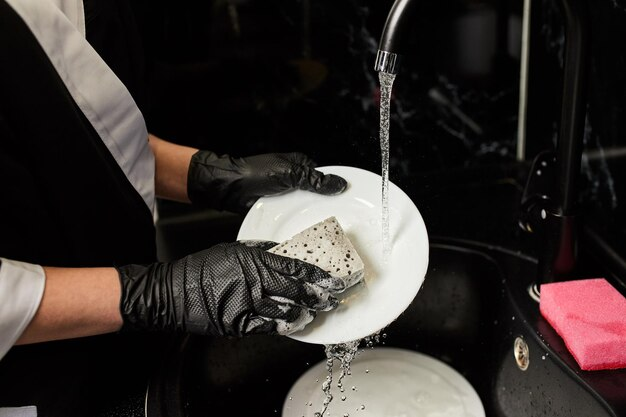56 9.6: Rinsing, Cleaning, and Sanitizing
9.6 – Rinsing, Cleaning and Sanitizing.
The FDA Food Code section 4-904.14 addresses the rinsing of equipment and utensils after cleaning and sanitizing, emphasizing the importance of maintaining proper sanitation practices in food service establishments. This regulation is designed to ensure that the sanitization process is not compromised by unnecessary rinsing, which could potentially reintroduce contaminants to clean surfaces.
Generally, equipment and utensils should not be rinsed after being cleaned and sanitized. This practice helps preserve the effectiveness of the sanitizers and disinfectants used in the cleaning process and prevents potential recontamination. The sanitizing step is crucial in reducing microbial populations on food-contact surfaces to safe levels, typically achieving a 5-log reduction of representative disease microorganisms. However, the Food Code does allow for rinsing under specific circumstances (FDA Food Code):
Warewashing Machine Application: Rinsing is permitted when applied directly from a potable water supply by a warewashing machine. This exception recognizes that some modern dishwashing equipment is designed with a final rinse cycle that uses fresh, potable water. Such machines must be properly maintained and operated according to the specifications in Subparts 4-204 and 4-501 of the Food Code.

Image courtesy of Freepix
EPA-Registered Sanitizer Requirements: Rinsing is also allowed when using certain chemical sanitizers whose EPA-registered label instructions specifically call for a rinse after application in a commercial warewashing machine. This provision acknowledges that some sanitizing agents may require removal to ensure food safety and comply with EPA regulations.
FDA Guidelines for Warewashing Maintenance and Operation
The FDA ensures proper maintenance and operation of warewashing machines through several key measures outlined in the Food Code and implemented by local health authorities:
Certification Requirements: The FDA Food Code recommends using warewashing machines that are certified by accredited organizations like NSF International. This certification ensures that the equipment meets or exceeds FDA Food Code requirements.
Data Plate Compliance: Warewashing machines must be operated in accordance with the machine’s data plate and manufacturer’s instructions. This ensures that the equipment is used as intended and maintains proper sanitization levels.
- Temperature and Chemical Standards: The FDA specifies minimum wash tank temperatures for high-temperature sanitization (150°F-165°F) and chemical sanitizing machines (120°F). Final rinse temperatures for high-temperature sanitization must reach at least 180°F.

Image courtesy of Freepix
The Importance of Employee Dishroom Training
Employee training plays a crucial role in maintaining food safety in dishrooms, serving as a cornerstone for ensuring proper sanitation and hygiene practices. Effective training programs for dishroom staff encompass several key aspects (FDA):
Machine Operation: Operators must be thoroughly trained on how to use warewashing machines correctly. This includes understanding proper temperature settings, chemical dosing, and cycle times. Staff should also be taught to recognize signs of equipment malfunction, as “sanitization can’t be seen” and dishes may appear clean while still harboring pathogens.
- Cleaning Protocols: Training should cover detailed cleaning procedures for both the dishroom and the warewashing equipment. Daily cleaning following manufacturer recommendations helps prevent breakdowns, malfunctions, and the redeposition of food debris on clean ware.
Personal Hygiene: Dishroom staff must be educated on the importance of personal cleanliness, including frequent hand washing and changing of aprons or uniforms to avoid contaminating clean dishes.
Food Safety Fundamentals: Employees should understand basic food safety principles, including temperature control, cross-contamination prevention, and safe food handling techniques.
Regulatory Compliance: Training should cover current food safety regulations and standards to ensure that staff are aware of legal requirements and best practices.
By consistently investing in regular food safety training, kitchens can cultivate a culture food safety culture where safety is not just a requirement, but a fundamental aspect of daily operations. This approach not only protects public health but also enhances the restaurant’s reputation and operational efficiency.
